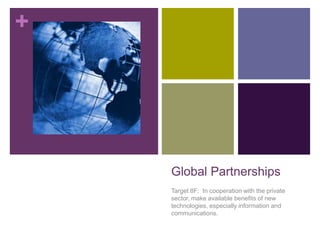Global Partnerships, Target 8F
- 1. Global PartnershipsTarget 8F: In cooperation with the private sector, make available benefits of new technologies, especially information and communications.
- 2. Target 8F:Demand grows for information and communications technologyA large gap separates those with high-speed Internet connections, mostly in developed nations, and dial-up usersAccess to the World Wide Web is still closed to the majority of the world’s people
- 3. Information & Communications Technology (ICT)The study of the technology used to handle information and aid communication. The phrase was coined by Stevenson in his 1997 report to the UK government and promoted by the new National Curriculum documents for the UK in 2000.In addition to the subjects included in Information Technology (IT), ICT encompasses areas such as telephony, broadcast media and all types of audio and video processing and transmission. (Source: http://foldoc.org/Information+and+Communication+Technology)
- 5. Global ICT DevelopmentsBy the end of 2007, almost one out of two people had a mobile phone.In Europe, penetration has surpassed the 100% mark.More than one out of 4 African and one out of 3 Asian have a mobile phone.A high level of competition and a decrease in prices have been able to reduce the digital divide in mobile telephone substantially. (Source: http://www.itu.int/ITU-D/ict/statistics/ict/index.html)
- 6. ICT Development: AfricaEspecially in Africa, where mobile is clearly dominating, fixed telephone lines remain the exception and penetration is at 3 per 100 inhabitants, by far the lowest in the world.The limited availability of fixed lines has also been a barrier to the uptake of fixed broadband and it is most likely that Africa’s broadband market will be dominated by mobile broadband.Data shows that while uptake is on the rise, the rollout of mobile broadband services is concentrated in the developed world. Falling prices and the increasing licensing and availability of 3G is expected to change this over the coming years. (Source: http://www.itu.int/ITU-D/ict/statistics/ict/index.html)
- 7. The Digital DivideThe digital divide remains a major problem in terms of Internet and especially broadband uptake.While fixed broadband penetration is growing rapidly and has reached around 15 and 10 percent in Europe and the Americas, it stands at less than half a percent in Africa.Internet use, in general, remains low in Africa especially, where only 5 percent of the population is online, compared to over 40 percent in Europe, the Americas, and Oceania. (Source:http://www.itu.int/ITU-D/ict/statistics/ict/index.html)
- 8. Developed vs. Developing Countries: Telephone LinesThe fixed line sector remains the least dynamic sector and while the number of fixed lines have actually been falling in developed countries, the are growing only very slowly in the developing world, where (at 16%) they remain at a low level.
- 9. Developed vs. Developing Countries: Mobile DevicesMobile growth remains strongest in the developing world. By end 2007, 45 out of 100 inhabitants in the developing world have a mobile phone.
- 10. Developed vs. Developing Countries: Internet UsersContrary to what is happening in the mobile sectors, Internet use is not growing as quickly in the developing world as in the developed world. By the end of 2007, less than one out of five people living in the developing world were online, compared to over 60 percent of people in the developed world.
- 11. 2004-2006 Data on ITC Around the WorldEurope/CIS in 2004, and Asia-Pacific, Americas, and Africa in 2006ICT By Region
- 12. ICT By Region: AfricaIn 2006, Africa accounted for 14% of the world’s population, but for only 5.6% of all fixed and mobile subscribers worldwide.Africa had by far the world’s lowest penetration of fixed lines, with a continental average of around 3 main lines per 100 people.In 2006, Africa had over 20 countries which had a national average of fewer than 1 main line serving every 100 people.Statistical DataTelephone SubscribersFor more information, visit: http://www.itu.int/ITU-D/ict/statistics/ict/index.html
- 13. ICT By Region: AmericasIn 2006, the Americas showed continued growth in the mobile sector, with most countries in South and Central America showing mobile penetration rates of over 50 percent.The Americas’ three largest fixed telephone networks – in the US, Canada and Brazil – account for more than 80% of all fixed lines on the two continents.The Americas also had the highest ratio of broadband subscribers to total Internet subscribersStatistical DataInternet SubscribersFor more information, visit: http://www.itu.int/ITU-D/ict/statistics/ict/index.html
- 14. ICT By Region: Asia-PacificInternet penetration ranges from below 1% in economies like Timor-Leste, Myanmar, Bangladesh, Cambodia, Lao P.D.R. and Nepal, to above 65% in Japan, Republic of Korea, Australia and New Zealand.Mobile penetration ranges from below 1% in economies like Myanmar and Kiribati, to 90% or more in Australia, Taiwan (China), Singapore, Hong Kong (China) and Macao (China).During 2006, India was the top country to add an average of 6.3 million new mobile subscribers every month. However China represents almost 43% of the entire Asia-Pacific mobile market in terms of subscriber numbers. The domestic penetration in China still hovers at around 35%. Statistical DataInternet SubscribersFor more information, visit: http://www.itu.int/ITU-D/ict/statistics/ict/index.html
- 15. ICT By Region: EuropeEurope lead the world in terms of mobile penetration, with over 570 million subscribers and a mobile penetration of over 70%. This compared with 9% mobile penetration in Africa, 42% in the Americas, and 19% in Asia Pacific.Europe had more mobile subscribers than fixed phone lines in almost all countries.Europe also showed strong mobile growth, particularly in Central and Eastern European countries, where 2004 mobile penetration levels rivaled those of the west. A few examples: Bulgaria (60%), Croatia (58%), Czech Republic (105%), Hungary (89%), Poland (60%), Slovak Republic (79%), and Slovenia (87%).Statistical DataInternet ComparisonFor more information, visit: http://www.itu.int/ITU-D/ict/statistics/ict/index.html
- 16. Presentation by:Grace DopicoAll information compiled in this presentation belongs to:The International Telecommunications Union
















